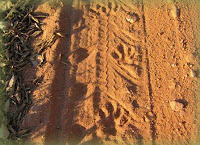‘To delight in the
aspects of sentient ruin might appear a heartless pastime, and the pleasure, I
confess, shows the note of perversity.’
~ Italian Hours, Henry
James.
 As a rule, old farm buildings in
Ireland are allowed to slide into neglect and decay. But it is possible to give a simple former
farm house new purpose and convert the building into an attractive residence. If only
there were more instances of such intelligent recycling to be found.
As a rule, old farm buildings in
Ireland are allowed to slide into neglect and decay. But it is possible to give a simple former
farm house new purpose and convert the building into an attractive residence. If only
there were more instances of such intelligent recycling to be found.
‘In an orderly
country,’ chided the German travel writer and ethnographer Johann Georg Kohl
after a visit to Ireland in September 1842, ‘ruins should really not be
tolerated. They should be demolished either in order that the material of which
they consist can be availed of in constructing new and more useful buildings,
or the site that they occupy can be put to different use, or because they
threaten to collapse completely and endanger human activity, or because they
present an unpleasant sight.’
Kohl believed that
members of ‘an orderly, vigilant and progressive human community’ should
eradicate all ruins, before he went to note that, ‘In Ireland, the opposite to
all this has happened, as it is unique in all of Europe for its many ruins. One
finds here a plethora of ruins from all periods of history, like in no other
country.’ Furthermore, he remarked, this melancholy condition was not unique to
ancient buildings since ‘down to our days every century – one could say every
decade – has deposited its ruins on the land. For everywhere one sees a multitude
of dilapidated houses that have only recently fallen into ruin but yet seem
also to have been built only recently.’
 More than 170 years after Kohl
made his observations, they remain pertinent.
What is especially noticeable is the gratuitous abandonment of buildings
for no apparent reason other than the fallacious notion that they have ceased
to be fit for purpose. This is especially true of the country’s older domestic
dwellings, ripe for adaptation to contemporary use but instead deserted in
favor of something newer – something which will in turn no doubt suffer the
same fate. Hence throughout the countryside one comes across a superabundance
of farmhouses which with just a modicum of inventiveness and panache could be
given a fresh leases of life as an alternative to their more common fate, which
is to molder into ruin.
More than 170 years after Kohl
made his observations, they remain pertinent.
What is especially noticeable is the gratuitous abandonment of buildings
for no apparent reason other than the fallacious notion that they have ceased
to be fit for purpose. This is especially true of the country’s older domestic
dwellings, ripe for adaptation to contemporary use but instead deserted in
favor of something newer – something which will in turn no doubt suffer the
same fate. Hence throughout the countryside one comes across a superabundance
of farmhouses which with just a modicum of inventiveness and panache could be
given a fresh leases of life as an alternative to their more common fate, which
is to molder into ruin.
Such might well have been the
fate of our project had it not been discovered by the present owner. It is in a
style that had remained almost unaltered over the previous hundred years. Unoccupied for more than half a century its
isolation seems to have discouraged anybody else from settling there. Today
that remoteness gives the place its appeal, as do the surrounding vistas of
rolling fields and an uninterrupted view of the Sea below. During the summer months, the owner has been
known to descend to the shore for a swim.
Aside from inaccessibility,
another reason why the building would not have won widespread favor is its
understated design: unlike smaller and more overtly endearing thatched
cottages, the average Irish farm house was never known for superfluous
embellishment. Indeed this particular example possesses an unpretentious
simplicity typical of the genus. It rightly celebrates the virtues of clean,
un-fussy composition.
But before these can be celebrated an extensive
program of refurbishment is called for.


































